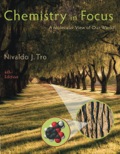
Interpretation:
The necessity for home water treatment for heath reason is to be explained and the reason behind its desirability is to be stated.
Concept Introduction:
Water is a common liquid that is present on the Earth.
It is also known as universal solvent. It can dissolve a wide range of organic and inorganic solutes.
Water is vital for the existence of all living animals. Without water, no life form can exist, it constitutes an important part of rivers, lakes, streams, clouds, snow and ice.
Water is truly an unusual molecule such that being a low molar mass compound, it exists as a liquid at room temperature and has an anonymously high boiling point.
Ice floats on water because it has a lower density than water.
Water contains some unwanted particles which can lead to diseases and other hostile effects on human health.
Numerous particles and microbes, such as bacteria can contaminate the water.
Biological contaminants: Some microbes can live in water and can cause various diseases like cholera, dysentery, and so on. Two examples of such microbes are Giardia and Legionella.
Inorganic contaminants: Some inorganic molecules can dissolve in water and make it impotable (not suited for drinking). Two examples of such molecules are Nitrates and Asbestos.
Organic contaminants: Some organic molecules can dissolve in water and makes it impotable (not suited for drinking). Two examples of such molecules are chlorohydrocarbons (volatile) and ethylbenzene (non-volatile).
Radioactive contaminants: Some radioactive elements can dissolve in water and make it impotable (not suited for drinking). Two examples of such elements are Uranium and Radium.
Contaminants that pose immediate health risks are the biological contaminants and inorganic contaminants because they get immediately dissolved in blood and starts reacting with it.
Contaminants that can be eliminated by boiling are the biological contaminants because the microbes can be killed by increasing the temperature.
Drinking water is made safe by using some techniques such as filtration, sedimentation and so on.
Drinking water is also made safer at homes by using techniques such as carbon filtration, water softening and reverse osmosis.
Want to see the full answer?
Check out a sample textbook solution
Chapter 12 Solutions
Chemistry In Focus
- The following intermediates are to proceed by acetoacetic ester synthesis. What are intermediates 1 and 2 plus the final product 3? Please include a detailed explanation and drawings of the intermediates and how they occurred.arrow_forwardThe chemical formula of "benzimidazole E" is C7H6N2. Draw it.arrow_forwardBriefly comment (without formulas) on the steps of the aldol condensation mechanism in acidic and basic media.arrow_forward
- The following intermediates are to proceed by acetoacetic ester synthesis. What are intermediates 1 and 2 plus the final product 3? Please include a detailed explanation and drawings of the intermediates and how they occurred.arrow_forwardWhat are the missing intermediates 1, 2, and 3? Please include a detailed explanation explaining the steps of malonic ester synthesis. Please include drawings of the intermediates and how they occur.arrow_forwardWhat is the reactant that makes the following product of the reaction? Please provide a detailed explanation and a drawing to show how the reaction proceeds.arrow_forward
- Draw the products formed when each ester is hydrolyzed with water and sulfuric acid.arrow_forwardDraw the complete structural formula from each condensed structure. include all hydrogen atoms.arrow_forwardDraw the complete structural formula from each condensed structure. Include all hydrogen atoms.arrow_forward
 Chemistry: The Molecular ScienceChemistryISBN:9781285199047Author:John W. Moore, Conrad L. StanitskiPublisher:Cengage Learning
Chemistry: The Molecular ScienceChemistryISBN:9781285199047Author:John W. Moore, Conrad L. StanitskiPublisher:Cengage Learning
 Chemistry for Today: General, Organic, and Bioche...ChemistryISBN:9781305960060Author:Spencer L. Seager, Michael R. Slabaugh, Maren S. HansenPublisher:Cengage Learning
Chemistry for Today: General, Organic, and Bioche...ChemistryISBN:9781305960060Author:Spencer L. Seager, Michael R. Slabaugh, Maren S. HansenPublisher:Cengage Learning World of Chemistry, 3rd editionChemistryISBN:9781133109655Author:Steven S. Zumdahl, Susan L. Zumdahl, Donald J. DeCostePublisher:Brooks / Cole / Cengage LearningChemistry: Matter and ChangeChemistryISBN:9780078746376Author:Dinah Zike, Laurel Dingrando, Nicholas Hainen, Cheryl WistromPublisher:Glencoe/McGraw-Hill School Pub Co
World of Chemistry, 3rd editionChemistryISBN:9781133109655Author:Steven S. Zumdahl, Susan L. Zumdahl, Donald J. DeCostePublisher:Brooks / Cole / Cengage LearningChemistry: Matter and ChangeChemistryISBN:9780078746376Author:Dinah Zike, Laurel Dingrando, Nicholas Hainen, Cheryl WistromPublisher:Glencoe/McGraw-Hill School Pub Co





